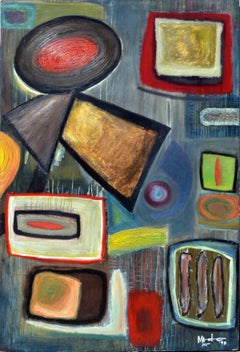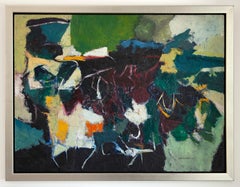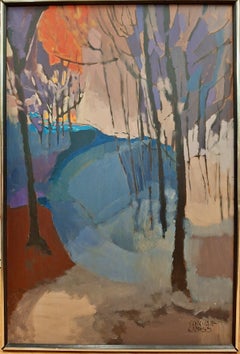Michael Mercado Abstract Paintings
to
1
1
Overall Width
to
Overall Height
to
1
1
1
1
1
1
1
1
1
666
627
362
342
1
Artist: Michael Mercado
The Three Peppers - Geometric Abstract
By Michael Mercado
Located in Soquel, CA
Boldly colored geometric abstract expressionist painting by California artist Michael Mercado (American, 20th Century). Signed lower right "M. Mercado '90" and Michael Mercado on ve...
Category
1990s Contemporary Michael Mercado Abstract Paintings
Materials
Masonite, Oil
$1,480 Sale Price
20% Off
Related Items
Edge
Located in Austin, TX
Waterline Fine Art, Austin, TX is pleased to present the following work:
Oil on board. Signed and dated lower right and verso, titled verso.
36.25 x 48 in.
40.5 x 52.25 in. (framed)
Framed in contemporary silver, tiered floater frame.
Dennis Eugene Norman Burton was a Canadian modernist who was born in Lethbridge, Ontario. He attended the Ontario College of Art from 1952 to 1956, and worked for the Canadian Broadcasting Corporation (CBC) as a graphic designer until 1960.
Inspired by a 1955 exhibition of the “Painters Eleven” at Toronto’s Hart House, as well as American Abstract Expressionist artists such as Robert Motherwell, Jack Tworkov, and Willem de Kooning, Burton shifted his focus toward abstraction in the mid-1950s.
Burton showed with the famed Isaacs Gallery in Toronto, becoming one of the youngest members on the gallery’s roster. A talented musician, he also played saxophone in the Artist’s Jazz Band in Toronto - a pioneering Canadian free-jazz group...
Category
1950s Abstract Expressionist Michael Mercado Abstract Paintings
Materials
Masonite, Oil, Board
A Summer's Sunset
Located in San Francisco, CA
In this abstract landscape, artist Geneva Cross conveys the mood of a dreamlike summer evening that might be remembered by any of us in its universality. Blending the basic elements ...
Category
1970s Abstract Michael Mercado Abstract Paintings
Materials
Masonite, Oil
Tropical Fantasy Floral - Still Life Flowers Painting by Marc Zimmerman
By Marc Zimmerman
Located in Carmel, CA
Tropical Fantasy Floral - Still Life Flowers Painting by Marc Zimmerman
Oil on board
Marc Zimmerman creates playful paintings, whether deep mysterious jungle or delightfully whimsic...
Category
2010s Contemporary Michael Mercado Abstract Paintings
Materials
Masonite, Oil
$3,120 Sale Price
20% Off
H 24 in W 36 in D 1.5 in
"Urban Renewal"
Located in Astoria, NY
Katherine S. Kirkman (American, XX-XXI), "Urban Renewal", Oil on Masonite, signed lower right, titled and signed to verso, wood frame. Image: 23.5" H x 19.5" W; frame: 26" H x 24" W....
Category
Late 20th Century Expressionist Michael Mercado Abstract Paintings
Materials
Masonite, Oil
Andrene Kauffman Circus or Zoo Abstract Oil Painting Chicago WPA Woman Artist
Located in Surfside, FL
Andrene Kauffman (American, 1905-1993)
Alter Ego.
Surrealist circus or zoo scene with flying animals on an abstract color saturated background.
Oil on masonite.
Hand signed ANKAU lower left.
Dimensions: 24 x 30”. Frame 25 ½ x 31 ½”.
There is a address label verso from Louise Dunn Yochim She was a well-known artist from Chicago in her time. Louise Yochim was born Luba Dichne in Zhitomir, Russia in 1909. She immigrated to Chicago, along with her parents and four siblings in 1924. Yochim studied at the European Gymnasium and at the Art Institute of Chicago, receiving her Master’s Degree and Doctorate (1962) in Education from the University of Chicago. She was married to notable Chicago artist Maurice Yochim. Yochim exhibited at the Art Institute of Chicago, the Renaissance Society of the University of Chicago, Chicago, IL, the Union League Club, Chicago, IL, the University Club of Chicago, the Cleveland Museum of Art, among others, becoming one of the leading women artists in Chicago. Yochim published three books, the most notable being “Role and Impact: The Chicago Society of Artists”, included in the Illinois Women Artists Project.
Camille Andrene Kauffman (1905 – 1993) was an American painter and educator who created a mural for the post office mural project in Ida Grove, Iowa. She completed twenty-five colorful murals and seven sculptures throughout Chicago, as part of the art projects for the New Deal's Section of Painting and Sculpture. Later, she completed seventeen ceramic murals for the 3rd Unitarian Church, which was designated as a Chicago Landmark in 1960. In addition to her artwork and exhibitions, Kaufman taught art for forty-one years at various universities in Chicago, Rockford, Illinois, and Valparaiso, Indiana. Her work bears the influence of Surrealism and Cubism.
Camille Andrene Kauffmann was born on April 19, 1905, in Chicago, Cook County, Illinois, to Charlotte Camille (née Henriksen) and George Francis Kauffman Kauffman came from an artistic family. Her father was a dress designer and her paternal grandfather, Francis Xavier Kauffman designed furniture. Her brother G. Francis would become a cartoonist and illustrator. She attended Austin Community Academy High School of Chicago before entering the Art Institute of Chicago, graduating in 1926 and winning the John Quincy Adams Fellowship from the Institute for a year of continued study abroad. In 1927, Kauffman went to Paris, where she studied with Andre Lhote and traveled throughout Europe, before returning in 1928 to take up a teaching post at Valparaiso University.
Kauffman was hired as a professor of Painting and drawing at the Art Institute of Chicago upon her return and simultaneously worked instructing art at Valparaiso University. Both assignments were part time and in 1933, when she was approached by the Works Progress Administration (WPA), she joined the federal program. During her time with the WPA, Kauffman produced over 50 easel paintings, 25 murals and 7 sculpture projects earning $24.50 per week. Some of her first works for the WPA were murals painted for the Brookfield Zoo, which was under construction at the time. Between 1936 and 1940, Kauffman painted four murals for the cafeteria of the Emil G. Hirsch Metropolitan High School including Amusement Park, Circus, Rodeo, and Stock Show The murals were painted over with house paint, but the outlines of the canvases are visible on the walls and might be able to be restored In 1937, Kauffman painted Incidents in the Life of Luther Burbank for the Luther Burbank School. The following year, she completed a second mural at the school, Circus. The murals at Burbank were still extant in 2001. The playground houses at Oak Park, Illinois, contain Kaufman's bas relief sculptures depicting fairy tales. These included a cast stone relief based on Thumbelina by Hans Christian Andersen, at the Watts Playground on Hayes Avenue at Division Street; a stone sculpture titled The Cutting of the Cake based on Lewis Carroll's Through the Looking Glass, for the Lincoln Playground at Kenilworth Avenue and Fillmore Street; and a cast stone work Captain Flint based on Robert Louis Stevenson's character at the Pyott Playground on Lake Street at Taylor Avenue. She painted murals at the Cook County Children's Hospital, but they were destroyed when the building was demolished, Kauffman created two bas reliefs for the Lincoln Elementary School in Evanston, Illinois. Children in Fruit Tree and Monkeys are intricate wood carvings with three-dimensional style. In addition, she completed commissions at the Washington School in Evanston and the Lowell School in Oak Park, as well as a mural for the Forest Park Public Library. In 1940, Kauffman won the federal commission to paint Preparation for the First County Fair in Ida Grove–1872 for the post office mural in Ida Grove, Iowa. Many great Chicago artists worked for the WPA including
Rainey Bennett...
Category
Mid-20th Century Michael Mercado Abstract Paintings
Materials
Masonite, Oil
Carmel's Romantic Mission San Carlos Borromeo Del Rio Carmelo
Located in San Francisco, CA
Without a doubt California's charming coastal village of Carmel compels one to romance. But this location, the 1797 Mission San Carlos Borromeo Del Rio Carmelo, with its lovely, foun...
Category
Mid-20th Century Pointillist Michael Mercado Abstract Paintings
Materials
Masonite, Oil
'On the Shore, ' by Erekle Chinchilakashvili, Oil on Masonite Painting
By Erekle Chinchilakashvili
Located in Oklahoma City, OK
This 20" x 23" oil on masonite painting by Georgian artist Erekle Chinchilakashvili depicts two blue trees near a brown pathway leading to the...
Category
2010s Contemporary Michael Mercado Abstract Paintings
Materials
Masonite, Oil
Erekle Chinchilakashvili'On the Shore, ' by Erekle Chinchilakashvili, Oil on Masonite Painting, 2020
$864 Sale Price
20% Off
H 20 in W 23 in D 0.8 in
Russian School Abstract Composition, 1988
Located in Astoria, NY
Russian School, Abstract Composition, Oil on Masonite, 1988, illegibly signed in Russian and dated lower right, inscribed in pencil to verso, painted frame. Overall: 11.25" H x 15.5"...
Category
1980s Abstract Expressionist Michael Mercado Abstract Paintings
Materials
Masonite, Oil, Wood
Large Sand And White Contemporary Textured Acrylic Painting By Anette Holmberg
Located in Frederiksberg C, DK
Introducing a beautiful acrylic painting on masonite by the Danish artist, Anette Holmberg.
Anette Holmberg (1969-) is a visual artist from Denmark (Scandinavia) with a master's de...
Category
Early 2000s Contemporary Michael Mercado Abstract Paintings
Materials
Acrylic, Masonite
$2,490
H 32.29 in W 48.04 in
Impressionism painting 4 Oil on panel by Pierre Vlerick (1923 - 1999)
Located in Gent, VOV
This painting is a perfect example of lyrical abstraction and a choice painting out of the best period of Vlerick's career.
Pierre Vlerick’s work shows...
Category
1960s Abstract Impressionist Michael Mercado Abstract Paintings
Materials
Masonite, Oil
$36,620
H 77.17 in W 53.55 in
Untitled (Cubist Portrait)
By Jerre H. Murry
Located in Los Angeles, CA
This work is part of our exhibition - America Coast to Coast: Artists of the 1940s
Untitled (Cubist Portrait), 1945, oil on masonite, signed and dated lower middle, 20 x 16 inches, remnant of exhibition label verso, perhaps exhibited at Murry's solo exhibition at the Los Angeles's Screen Cartoonists' Gallery, July , 1945, presented in its original frame
Jerre Murry was a California modernist painter. Born in Columbia, Missouri, Murry studied at the Detroit Academy of Art and worked as an artist for the Detroit News and Detroit Free Press. Murry traveled to the Bahamas, where he was inspired to paint modernist scenes of island life and people. By the early 1930s, Murry had relocated to Los Angeles, where he caught the attention of Synchromist painter Stanton Macdonald Wright, State Supervisor for the Federal Art Project (FAP) in Southern California. MacDonald Wright enrolled Murry into the FAP. Murry’s Gauguin-influenced painting Sun Image was exhibited together with other FAP artists at the Los Angeles County Museum of Art in 1936, and Murry was also included in the FAP exhibit at the Paris Exposition in 1937. Stendahl Galleries in Los Angeles, the Chamber of Commerce Gallery in Santa Barbara, and at the Los Angeles County Museum of Art also showed Murry’s work during the 1930s. Murry created a murals for Los Angeles Water & Power Company, the Boise, Idaho Post Office, and Glendale Junior College. In 1939, Murry's work was exhibited at the Golden Gate International Exposition and the New York World's Fair. He also was included in the All California Exhibition at the Los Angeles County Museum of art that same year. He went on to exhibit in Los Angeles at the Foundation of Western Art's Trends in Southern California Art shows in 1940 and 1941, at Raymond and Raymond Gallery in Hollywood and USC’s Elizabeth Holmes...
Category
1940s American Modern Michael Mercado Abstract Paintings
Materials
Masonite, Oil
St. Atomic oil and tempera painting by Julio de Diego
By Julio de Diego
Located in Hudson, NY
Julio De Diego’s Atomic Series paintings made an extraordinary statement regarding the shock and fear that accompanied the dawn of the nuclear age. In the artist’s own words, “Scientists were working secretly to develop formidable powers taken from the mysterious depths of the earth - with the power to make the earth useless! Then, the EXPLOSION! . . . we entered the Atomic Age, and from there the neo-Atomic war begins. Explosions fell everywhere and man kept on fighting, discovering he could fight without flesh.”
To execute these works, De Diego developed a technique of using tempera underpainting before applying layer upon layer of pigmented oil glazes. The result is paintings with surfaces which were described as “bonelike” in quality. The forms seem to float freely, creating a three-dimensional visual effect. In the 1954 book The Modern Renaissance in American Art, author Ralph Pearson summarizes the series as “a fantastic interpretation of a weighty theme. Perhaps it is well to let fantasy and irony appear to lighten the devastating impact. By inverse action, they may in fact increase its weight.”
Exhibited
1950 University of Illinois at Urbana "Contemporary American Painting"
1964 Marion Koogler McNay Art Institute, San Antonio, Texas
This work retains its original frame which measures 54" x 36" x 2".
About this artist: Julio De Diego crafted a formidable persona within the artistic developments and political struggles of his time. The artist characterized his own work as “lyrical,” explaining, “through the years, the surrealists, the social-conscious painters and the others tried to adopt me, but I went my own way, good, bad or indifferent.” [1] His independence manifested early in life when de Diego left his parent’s home in Madrid, Spain, in adolescence following his father’s attempts to curtail his artistic aspirations. At the age of fifteen he held his first exhibition, set up within a gambling casino. He managed to acquire an apprenticeship in a studio producing scenery for Madrid’s operas, but moved from behind the curtains to the stage, trying his hand at acting and performing as an extra in the Ballet Russes’ Petrouchka with Nijinsky. He spent several years in the Spanish army, including a six-month stretch in the Rif War of 1920 in Northern Africa. His artistic career pushed ahead as he set off for Paris and became familiar with modernism’s forays into abstraction, surrealism, and cubism.
The artist arrived in the U.S. in 1924 and settled in Chicago two years later. He established himself with a commission for the decoration of two chapels in St. Gregory’s Church. He also worked in fashion illustration, designed magazine covers and developed a popular laundry bag for the Hotel Sherman. De Diego began exhibiting through the Art Institute of Chicago in 1929, and participated in the annual Chicago Artists Exhibitions, Annual American Exhibitions, and International Water Color Exhibitions. He held a solo exhibition at the Art Institute of Chicago in the summer of 1935. Though the artist’s career was advancing, his family life had deteriorated. In 1932 his first marriage dissolved, and the couple’s young daughter Kiriki was sent to live with friend Paul Hoffman.
De Diego continued to develop his artistic vocabulary with a growing interest in Mexican art. He traveled throughout the country acquainting himself with the works of muralists such as Carlos Merida, and also began a collection of small native artifacts...
Category
1940s American Modern Michael Mercado Abstract Paintings
Materials
Masonite, Oil, Tempera
Michael Mercado abstract paintings for sale on 1stDibs.
Find a wide variety of authentic Michael Mercado abstract paintings available for sale on 1stDibs. You can also browse by medium to find art by Michael Mercado in masonite, oil paint, paint and more. Much of the original work by this artist or collective was created during the 1990s and is mostly associated with the abstract style. Not every interior allows for large Michael Mercado abstract paintings, so small editions measuring 32 inches across are available. Customers who are interested in this artist might also find the work of Alexander Eulert, Susan Kiefer, and Patricia A Pearce. Michael Mercado abstract paintings prices can differ depending upon medium, time period and other attributes. On 1stDibs, the price for these items starts at $1,480 and tops out at $1,480, while the average work can sell for $1,480.


